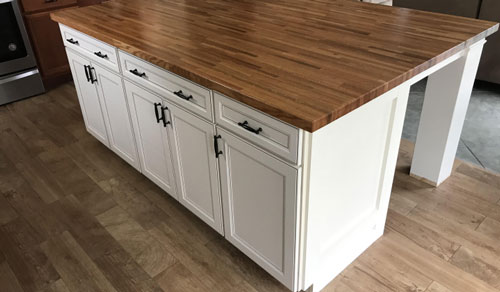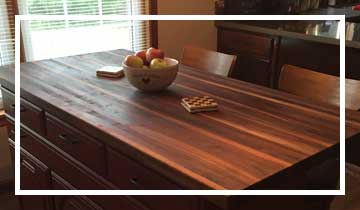How to Finish Butcher Block Countertops
Is it time to upgrade your residential kitchen and dining room?
Butcher block countertops are a popular choice because of their affordability and versatility. There are multiple options to choose from to complement the interiors of your home, including maple, walnut, oak, and hickory.
In addition, butcher block wood is quite forgiving. Even if the surface of your butcher block countertop becomes stained or receives dents and scratches from many years of daily use, you can still sand and refinish the wood to make it look it’s in “like-new” condition.
In this guide, we will cover the necessary steps for how to finish butcher block countertops. Let’s get started.
Get Pricing/Place Order

Steps for How to Finish Butcher Block Countertops
If you purchased an unfinished butcher block countertop or island, you will need to follow some steps before you can use your butcher block surface. The good news is that you can opt for the finish color of your choice for the perfect look for your kitchen.
It will require some work, but the finished results will look amazing!
Note: All our tops have a clear face, so you will not need to fill any cracks or seams in your butcher block.
How to Sand Butcher Block
- To start sanding your butcher block, you will sand both the tops and side of the butcher block. If you are able, you should sand the underside of the countertop as well.
- To sand, you should use 180-320-grit sandpaper. Sand lightly to achieve a smooth result. If needed, you may also want to use a dust extractor. A dust extractor can suck up dust and keep a much cleaner working area.
- When finished with sanding your butcher block, wipe down the wood to remove any remaining dust.
How to Condition Butcher Block
Note: We highly recommend permanently finishing your butcher block rather than conditioning it.
- If you haven't permanently finished your butcher block, the next step would be to condition your butcher block. You will want to use a conditioner that matches with the oil-based or water-based stain you plan on using.
- Apply a coat of conditioner as directed by your butcher block craftsman/seller.
- Allow your conditioner to dry.
- Next, you can lightly sand one more time if needed.
- When complete, wipe down the countertop with a tack cloth.
Finish/Stain Choices for Your Butcher Block
If you want to stain your butcher block, you will need to use an oil-based stain.
Oil-based stains – These are highly durable, soaking into the butcher block wood and forming a strong barrier which helps to protect the countertop from moisture. Choosing oil-based stain means that you are investing in a more scratch-resistant option when compared with a water-based stain. Oil-based stains come in a variety of colors. It is not food safe. Use only for butcher block surfaces that you don’t plan to use for food prepping.
Wood oils/mineral oils – An alternative to using oil-based stains is to use a wood or mineral oil. The benefit to these is that they are food safe. If you plan on using your butcher block countertops for food prepping, you will need to use a food-safe oil. Another benefit of wood or mineral oils is that when they soak into the butcher block, they bring out the natural coloration of the wood.
Staining Your Butcher Block
Before You Start: First try out the color. (You can do this on a scrap piece of butcher block or on the underside of the countertop.)
Now you are ready to stain.
- First, you will need to stain the entire top and sides of your butcher block countertop. If there is excess, you can wipe it away with a rag.
- Next, allow the stain to dry. (If you live in a more humid climate, use air conditioning to keep the humidity down while the stain dries.)
- Once dry, you can lightly sand the surface of your butcher block using a piece of sand paper to remove any apparent blemishes.
- To achieve the depth of color you want for your countertop, repeatedly stain and sand the butcher block until you get a color you like. The coloration may be a bit dull. If so, this is where sealer comes in.
How to Seal/Finish Butcher Block
What is the best sealer for butcher block countertops? The answer to this question will ultimately depend on whether you are going to use your butcher block surfaces for food preparation or not.
For example, if you chose an oil-based stain for your countertop (for no food preparation), you can use polyurethane to seal your butcher block. You will need to ensure that the poly is oil-based as well, as not all poly is.
The Sealing Process
The final step in finishing your butcher block is the sealing process. You have the option of a matte or gloss finish. Be sure to use a food-safe sealer if you plan on using your countertop for food preparation.
- 1. To start, use a foam brush to apply the sealer.
- 2. Allow the sealer to dry on the butcher block surface.
- 3. Repeat for a final coat.
NOTE: WE HIGHLY RECOMMEND OUR CUSTOMERS SEAL/FINISH THEIR BUTCHER BLOCK COUNTERTOPS

How to Maintain Butcher Block
Now that your butcher block countertop is finished, it is ready for use! Cleaning and maintaining your butcher block is a routine, but easy process.
With naturally occurring antimicrobial properties, butcher block wood is highly sanitary (more than plastic surfaces), especially as the cutting surface ages. This makes cleaning using harsh chemicals completely unnecessary and even damaging to your wood. Using mild dish soap, vinegar, salt, lemon, etc., is all that’s required for daily cleaning of your butcher block.
To clean and maintain your butcher block, follow these steps:
Maintenance Steps:
- Clean: To clean, use a mild dish soap with water, adding vinegar to the mixture as a sanitizer. Read more here on cleaning butcher block countertops.
- Sanding & Refinishing: If your butcher block has become stained or damaged by cutting or chopping, you can sand away the stains or cuts and then refinish the countertop. Sanding and refinishing your countertop will make it look “like-new” again.
- Scraper: Food stuck on your countertop? We recommend using a nylon scraper or a plastic scrubbing sponge to remove. (These are less likely to cause damage to your countertop than a metal tool will).
- Apply a New Coat: If you opted for mineral oil or high-quality beeswax, you will need to apply a new coat of the oil or beeswax once monthly whenever the wood has a dry appearance (or as directed by the craftsman/seller).
Using Waterlox® Oil
Note: For excellent results that take the hassle out of having to regularly oil your butcher block, we recommend permanently finishing/sealing the top of your butcher block with a product called Waterlox®. Waterlox® is a high-grade oil and resin blend that we’ve been recommending to our customers for many years.
Benefits of using Waterlox® for butcher block countertops:
- Showcases the natural beauty of the butcher block wood
- Provides long-lasting, highly durable protection
- Heat-resistant
- Will not crack, peel, or chip
- Locks out water
- No regular oiling or conditioning needed!
Read more about the benefits of Waterlox® on our finishing and care page.
How to Finish Butcher Block Countertops FAQs
How to finish butcher block countertops for kitchen?
To finish butcher block countertops in your kitchen, you'll need a variety of materials. These include different grits of sandpaper, mineral spirits, a food-safe sealer like mineral oil or tung oil, lint-free rags, paintbrushes, and rubber gloves. Start by removing any old finish and cleaning the surface thoroughly. Then begin sanding, starting with coarse-grit sandpaper and progressing to a fine grit for a smooth finish. After sanding, wipe down the surface using a lint-free cloth soaked in mineral spirits to remove any sanding residue. Next, apply your chosen sealer according to the manufacturer's instructions.
How to finish unfinished butcher block countertops?
Finishing an unfinished butcher block countertop is similar to finishing one that has been previously used, but generally easier because the wood is already sanded. First, lightly sand the surface with fine-grit sandpaper to prepare it for the sealer. Wipe down the countertop with a lint-free cloth dampened in mineral spirits to remove any dust. Apply your chosen sealer according to the manufacturer’s directions. Let the sealer dry and cure as per the guidelines on the packaging. For maintenance, remember to reapply the sealer as necessary.
How to finish and seal butcher block countertops?
Finishing and sealing butcher block countertops involve similar steps but with an emphasis on creating a water-resistant and food-safe surface. Choose a food-safe sealer like mineral oil or tung oil for the best results. Apply the sealer evenly on the surface, following the manufacturer's instructions. To add an extra layer of protection, you may consider applying multiple coats of the sealer, allowing each coat to fully dry before applying the next one. Keep in mind that regular maintenance is important for maintaining a water-resistant and durable surface.
How to finish butcher block countertops using pure tung oil?
Pure tung oil is a popular and food-safe option for finishing butcher block countertops. Start by lightly sanding the surface of the wood and then pour a small amount of pure tung oil onto a lint-free rag and apply the oil to the countertop using circular motions. Be sure to cover the entire surface. Wait for about 5-10 minutes, then use a clean rag to wipe off any excess oil. Tung oil may take a few hours to a few days to dry, depending on environmental conditions. For added protection, you can apply 2-3 additional coats, making sure to let each coat dry before applying the next.
About Forever Joint Tops
With over 50 combined years in the lumber business, our company is skilled with crafting quality butcher block countertops, bar tops, table tops, kitchen islands, and desktops for our customers since 2012! (Take a look at some of our desk ideas here.) At Forever Joint Tops, our team values our clients, and we are fully committed to "Quality that is Forever Yours." Our testimonials, Facebook reviews, and Google reviews all demonstrate our commitment to excellent customer service, hard work, and quality products.
You can customize your walnut, hard maple, red oak, or hickory butcher block countertops, or browse our in-stock offerings. Choose your desired corner radius, wood type, and more. If you need more information on the installation process, please read our 7 steps to wood countertop installation guide.
Get pricing or place an order today! Have questions about how to finish butcher block countertops, desks, kitchen islands, or floating shelves? Simply reach out to our experts at (608) 566-6903. Our team is looking forward to serving you. Read more here about what you need to know before installing butcher block.

